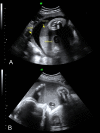Ichthyosis prematurity syndrome with separation of fetal membranes and neonatal asphyxia
- PMID: 22927265
- PMCID: PMC3433503
- DOI: 10.1136/bcr.02.2012.5823
Ichthyosis prematurity syndrome with separation of fetal membranes and neonatal asphyxia
Abstract
Ichthyosis prematurity syndrome (IPS) is a rare inherited skin disorder. Children are born prematurely with thick skin and have been found to develop neonatal asphyxia due to occlusions in the bronchial tree from debris in the amniotic fluid. At 31 weeks of gestation, separation of amniotic and chorionic membranes was identified as well as polyhydramnion. The child was born 2 weeks later, with thickened skin with a granular appearance and required immediate ventilation and intensive care. At 2 years of age, the patient has developed an atopic skin condition with severe itching, recurrent skin infections, food intolerance and periods of wheezing. Prenatal observation of separation of foetal membranes or dense amniotic fluid may be signs of IPS and severe complication immediately after birth.
Conflict of interest statement
Figures


References
-
- Oji V, Traupe H. Ichthyosis: clinical manifestations and practical treatment options. Am J Clin Dermatol 2009;10:351–64. - PubMed
-
- Akiyama M. Harlequin ichthyosis and other autosomal recessive congenital ichthyoses: the underlying genetic defects and pathomechanisms. J Dermatol Sci 2006;42:83–9. - PubMed
-
- Bygum A, Westermark P, Brandrup F. Ichthyosis prematurity syndrome: a well-defined congenital ichthyosis subtype. J Am Acad Dermatol 2008;59(5 Suppl):S71–4. - PubMed
Publication types
MeSH terms
Substances
Supplementary concepts
LinkOut - more resources
Full Text Sources
Medical
